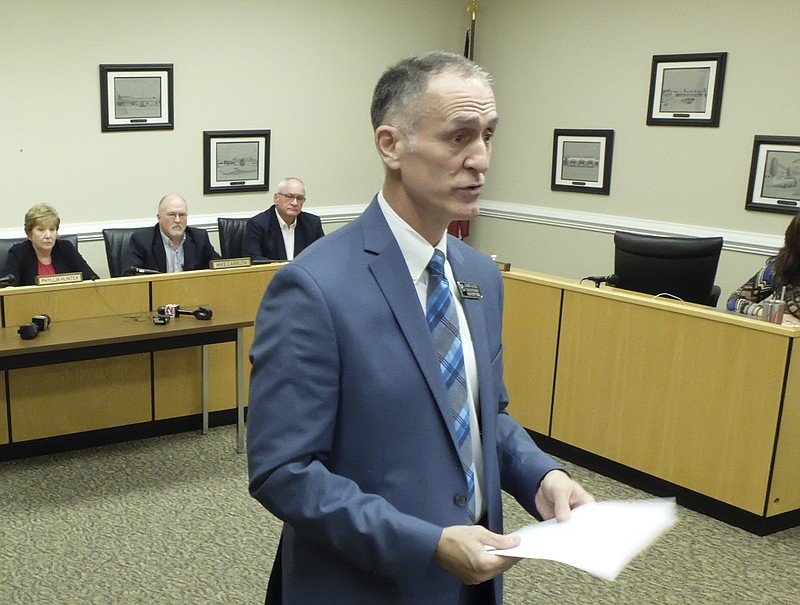The budget at a glance
RevenueFY 2018: $84.8 millionFY 2019: $86.6 million (2 percent increase)ExpensesFY 2018: $89.8 millionFY 2019: $92.4 million (2.8 percent increase)
More Info
Walker County Schools Budget HearingsJuly 10 at 5 p.m. 925 Osburn Road, Chickamauga, Ga.July 16 at 5 p.m. 201 S. Duke Street, LaFayette, Ga.
LAFAYETTE, Ga. - The bulk of Walker County Schools' new funding is going toward teachers' pensions.
The system plans to spend about $2.5 million on employee benefits this year, according to a tentative budget the board of education passed unanimously Monday night. That is about a 10 percent increase over the current fiscal year.
The budget released to the public is 17 pages and does not further break down how much money is spent on each exact benefit. But Superintendent Damon Raines told the board a big boost in spending comes from increased employer contributions for Georgia's Teacher Retirement System.
Last year, the Teacher Retirement System board voted to elevate employer contributions from 16.81 percent to 20.9 percent. The system has to take that figure and multiply it by employee payroll to determine how much it needs to provide to the retirement fund. (Employee contributions have stayed flat at 6 percent.)
According to the Teacher Retirement System's most recent annual report, which tracks finances through last summer, this is the biggest jump in a single year dating back to 2009.
"It is a great attractor," Raines said. "You're talking about a retention plan for teachers: That's what I preach to them all the time. It is the best out there. But we're fronting all that money. That's been tough on local folks."
School board member Bobby McNabb asked how much more money, exactly, the school district will pay this year for the pension fund. Director of Financial Services Bridgette Watts said she did not have the figure in front of her Monday night.
According to the Atlanta Journal-Constitution, the Georgia Legislature spent about $600 million the last two years on the pension fund, which costs $74 billion and covers 400,000 teachers, University System of Georgia employees and retired educators. About 74 percent of the system's liability is covered this year, compared to about 84 percent in 2014. Financial advisers suggest covering at least 80 percent of the liability.
The school district also plans to spend more money on employee health insurance. Beginning this year, non-certified employees will receive the same level of funding from the district as certified teachers do, which Raines said was the state government's call. Non-certified employees can include custodians, bus drivers and cafeteria workers.
The benefits portion of the budget provided to the public does not say exactly how much more is going toward health insurance.
"I'm glad the employees, it's not coming out of their pocket," board chairman Mike Carruth said. "But it's pretty tough, you know, on the system to keep raising."
Overall, spending is up about $2.5 million in this budget, compared to last year. That is a 2.8 percent increase. The school district also projects to receive about $1.6 million more this year, which is a 2 percent increase.
About $1 million is coming from the state. The district is getting about $1.4 million more from the Quality Basic Education formula, which takes into account factors such as how many students a school system educates. The state legislature also did away with about $1 million in "austerity" cuts.
At the same time, property values in the county rose this year, and the system will receive about $1 million less in equalization funding - the extra money the state gives systems in poorer communities to make up for smaller local tax bases. The increased values mean the district also has to contribute about $350,000 more to qualify for state funding.
Locally, the district projects about $600,000 more from title taxes. Walker County Tax Commissioner Carolyn Walker said that is because the Georgia Department of Revenue has recalculated the cut the local government receives on that levy. Last year, local governments got about 43 percent of the revenue. This year, they get about 52 percent.
Raines said the district also will hire 14 new employees this year: four teachers in general education classes, four special education teachers, three media specialists and three school resource officers.
On Tuesday, the board voted to boost funding for the non-certified employees' retirement fund. Six years ago, Raines said, the board cut the funding level from 5 percent to 3 percent. But this year the contributions will go back to the previous rate. That will cost the district about $80,000.
"We took this away from our people," McNabb said. "I think we should give it back."
The budget includes a couple of significant cuts under instructional services. "Instructional allotments" is down $317,000 (a 38 percent decrease), and "learning resources" is down $200,000 (a 45 percent cut).
After Monday's meeting, Raines said he believes a significant amount of money for instructional allotments was the result of the district receiving grants last year. He was not sure of the details of those $517,000 in cuts as of late Monday.
Contact staff writer Tyler Jett at 423-757-6476 or tjett@timesfreepress.com. Follow him on Twitter @LetsJett.
